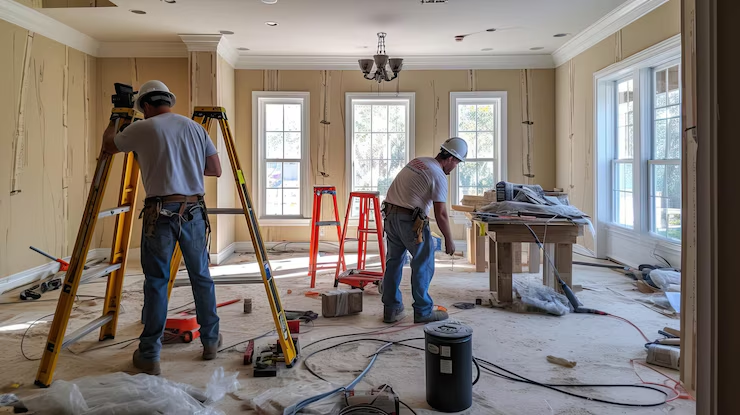Introduction
Home renovations can be life-changing. Whether you’re upgrading your kitchen, refreshing your bathroom, or finally building that dream outdoor space, the right improvements can transform how you live — and boost your property’s value. But here’s the truth: even well-intentioned renovations can spiral into financial disasters if you’re not careful. From underestimating costs to hiring the wrong contractor, small missteps can cost you thousands. In this post, we’ll walk you through the 7 most common home renovation mistakes and show you exactly how to avoid them — so you can renovate smart and stress-free.
1. Skipping the Planning Stage
Many homeowners dive into renovations head-first without a detailed plan. The excitement to get started often leads to decisions being made on the fly, which results in scope creep, budget blowouts, and design regrets. Every successful renovation begins with a comprehensive plan. Create a detailed scope of work, take accurate measurements, map out a realistic timeline, and work from drawings or blueprints. Without this, even simple jobs become chaotic. Real example: A homeowner started a kitchen remodel without measuring appliance clearances. After installing cabinets, they realized the fridge door wouldn’t open fully. Fixing the error cost over $2,000. Pro Tip: Use design tools like SketchUp or RoomSketcher to visualize your space before work begins.
2. Underestimating the Budget
It’s easy to underestimate how much a renovation will cost, especially when focusing only on material prices. Labor, permits, delivery fees, and unexpected issues often push the final total far beyond the initial estimate. A good rule of thumb is to add a 20% buffer for surprises like mold, asbestos, or structural fixes. Also, keep in mind that prices for trades and materials can fluctuate based on demand, supply chain issues, or location. Skimping on your budget upfront often leads to cutting corners mid-project or leaving things unfinished. Pro Tip: Request itemized quotes from contractors so you understand where every dollar is going.
3. Hiring the Cheapest Contractor
Choosing the lowest bid might seem smart at first — until you realize why it’s so low. A cheaper contractor may cut corners, use subpar materials, or lack experience, resulting in costly repairs later. Some may also lack insurance or licensing, putting you at risk. Always vet your contractor thoroughly: ask for references, check their portfolio, verify licenses, and read reviews. Don’t just go by word-of-mouth. Real example: A couple hired a cheap kitchen contractor who didn’t seal their backsplash properly. Within a few months, water damage caused $6,000 in repairs. Pro Tip: The best contractors are often booked out weeks or months in advance. Plan ahead and don’t rush the hiring process.
4. Ignoring Permits and Building Codes
Skipping permits might save time and fees in the short term, but it can result in serious legal and financial consequences. Unpermitted work can delay the sale of your home or lower its value. Worse, insurance may not cover damage caused by illegal work. Whether it’s electrical rewiring, structural changes, or plumbing relocations, make sure proper permits are pulled and inspections are completed. Some homeowners have had to undo finished renovations at great expense just to get city approval later. Pro Tip: Always ask your contractor who is responsible for securing permits — you don’t want that responsibility passed back to you unexpectedly.
5. Choosing Style Over Function
Trendy designs may look amazing on Pinterest, but they don’t always work in real life. Prioritizing aesthetics over function leads to inconvenience and regret. For example, open shelving looks great but doesn’t hide clutter. Freestanding tubs are luxurious but can be hard to clean around. Always consider how a space will be used daily before committing to bold design choices. Pro Tip: Tour model homes or recent renovations to test features before you commit. Think long-term usability, especially if you plan to age in place or sell in a few years.
6. DIYing Work That Requires a Pro
DIY renovations can save money, but some jobs should always be left to licensed professionals. Electrical, plumbing, structural modifications, and gas work all require specific skills — and doing them incorrectly can be dangerous and expensive. YouTube tutorials can help with painting or tiling, but they won’t replace years of training for more complex systems. Real example: A homeowner tried to rewire their laundry area without a permit or electrician. A minor short led to a fire, resulting in $25,000 in damages and an insurance claim that was denied due to unlicensed work. Pro Tip: Save your DIY energy for cosmetic updates. Call the pros for anything that affects safety, structure, or code compliance.
7. Failing to Communicate with Your Contractor
Even with a great contractor, lack of communication can derail a renovation. Misunderstandings over finish selections, timelines, or changes can create delays and extra costs. Set clear expectations from the beginning. Use written contracts, document any changes, and have regular check-ins during the project. Communication also includes being available to answer questions, approve decisions, and resolve issues quickly. Real example: A homeowner missed several contractor calls about tile selection. The crew had to pause for three days, adding delay fees to the final invoice. Pro Tip: Keep a shared project folder or app (like Buildertrend or Trello) for updates, photos, and ongoing documentation.
Conclusion
Home renovations are exciting opportunities to improve your living space and increase property value — but they also carry financial risks. From planning and budgeting to hiring and execution, every step matters. Avoiding these seven costly renovation mistakes will help you stay on track, on budget, and in control. Take the time to plan properly, work with licensed professionals, and prioritize communication. When done right, your renovation will not only look great but also add lasting value to your home and peace of mind to your daily life.


